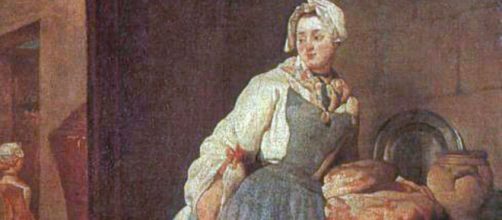Rebellion has always been art’s underpinning: Baroque pushed back against Renaissance until it surrendered to Rococo in advance of Neo-classical and before the coming of Impressionism. On and on. Each style was an insurgency against what came before. Every once in a while, though, an artist will resist his own time.
Jean Baptiste-Simeon Chardin lived in the 18th century when painters, weary of Baroque art’s melodramas in the previous century, sought a less weighty look. This is when the extravagant decorative arts at Louis XIV’s Versailles held sway over artmaking, a style called Rococo.
Running counter
Chardin would have none of that. You can see this is in a group of 27 paintings and drawings long owned by the Marcille family and now on the auction block at Christie’s in France. Pierre Etienne, Director of the Department of Old Master Paintings, told ArtDaily: “The name Marcille evokes the excellence of the French 18th century.”
You don’t need a sales pitch to tell you Chardin was distinct. You can see it in his work. Consider "Young Student Drawing," a painting of a young man sitting on the floor, bent over his drawing pad with intense concentration.
Chardin painted this image while fellow painter Francois Boucher was painting portraits of Madame de Pompadour, mistress of Louis XV in her lavish boudoir.
It’s notable that the first buyer of Chardin’s Young Student Drawing in 1848 was noted bridge designer the Isambard Kingdom, another Frenchman unhappy with the frivolousness of Rococo.
Making art
The trials of artmaking were clearly on Chardin’s mind again in Attributes of Art in which he pictured the tools of an artist – palette and brushes – which, in effect, is a still-life.
It’s no wonder that the novelist Marcel Proust wrote that Chardin taught him a pear is as living as a woman.
Not that Chardin’s subject matter was always about artmaking. I’m thinking of his painting Back from the Market - a weary woman just arrived home laden with groceries. Some art historians say she is a maid. If so, it’s notable that Chardin would paint a servant rather than a woman of the court.
The woman leans an arm on a sideboard as if waiting for a second breath before storing the groceries and preparing a meal. She glances over her shoulder, perhaps to listen to her children playing in the next room. You can’t get more every day than this and more far from the court life of Louis XV.
Simplicity marks Chardin’s work. The light on the woman’s face and on the wooden sideboard, likely from a window across the room, is so soft that you want to enter the painting and help out. He saw the beauty of a single moment. No wonder Chardin is known as the French Vermeer.
As if to dispel any notion that Chardin was the typical Rococo lightweight, historian Charles Nicolas Cochin cited an incident when Chardin became annoyed by a fellow painter’s bloviating about painting with color: “Since when does one paint with color?” he said.
“You should paint with your feelings.”
Cochin cited another instance of Chardin’s impatience with blather about art. A noblewoman he worked for told him, “My butler has been learning to paint for the past eight days... A few more lessons and he ought to be able to produce a painting, don’t you think?”
Chardin’s answer? “He can, if you like, finish my painting because I’m off.” No fawning - for him.


